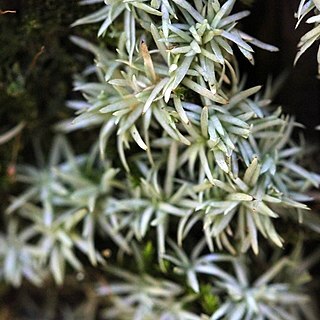Plants small to medium, loosely caespitose, glaucous-green; corticolous. Stems 2-4 mm high, unbranched; in section round, central strand absent, cortical cells large, in 5 rows, outer row slightly thickened. Leaves squarrose above base wet or dry, oblong above a wider, oval base, 4-5 mm long; apex rounded, abruptly apiculate; margins plane, entire or serrulate at apex. Costa filling upper leaf; in distal section reniform, chlorocysts small, triangular, ventral leucocysts in 3 layers, dorsal leucocysts in 2 layers. Laminal cells quadrate; basal cells rectangular; leucocysts thin-walled, with large lateral pores. Gemmae or rhizoidal growth frequent at leaf apices, gemmae clavate, 4-6 cells long. Autoicous. Perigonia scattered along stem; perichaetia terminal, leaves undifferentiated. Seta 3-4 mm long, straight; capsule small, erect, urn ovoid, ±1 mm long, symmetrical; peristome short, teeth 8, triangular, 0.1-0.2 mm long, yellow-brown; operculum rostrate, beak oblique; calyptra cucullate, deciduous; spores round, 17-20 µm, granulose.
More
Plants glossy, glaucous-green to white, often with pink tinge; densely cespitose; axillary hairs 3 per axil, 5-celled. Leaves spreading-recurved, fleshy, fragile when dry, 4-5 mm, apiculate, older leaves sometimes with rhizoids on tips. Specialized asexual reproduction rare, by gemmae. Seta yellow, 2-5 mm. Capsule brownish, 1-1.5 mm, ovoid-cylindric, slightly asymmetric, with stomata at base; operculum 0.8 mm; peristome of 8 blunt triangular pairs of teeth, teeth smooth or faintly striate, 200 µm tall, each composed of one interior and one exterior layer of intact, empty, cell-like plates; prostome present. Calyptra 1.5-1.9 mm. Spores finely papillose, 17-24 µm.

